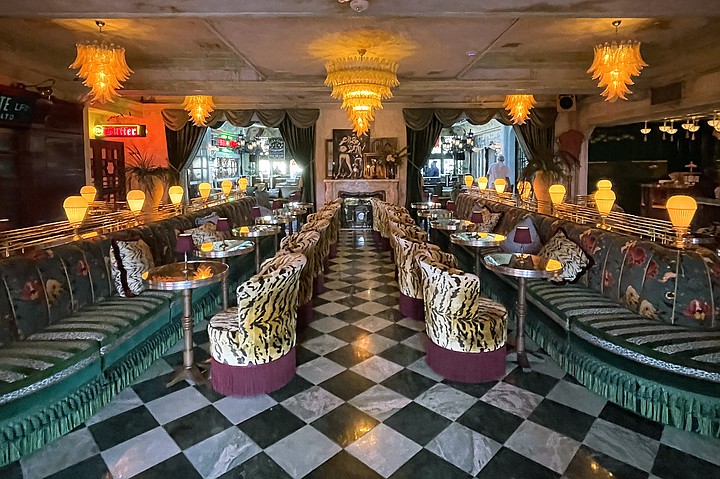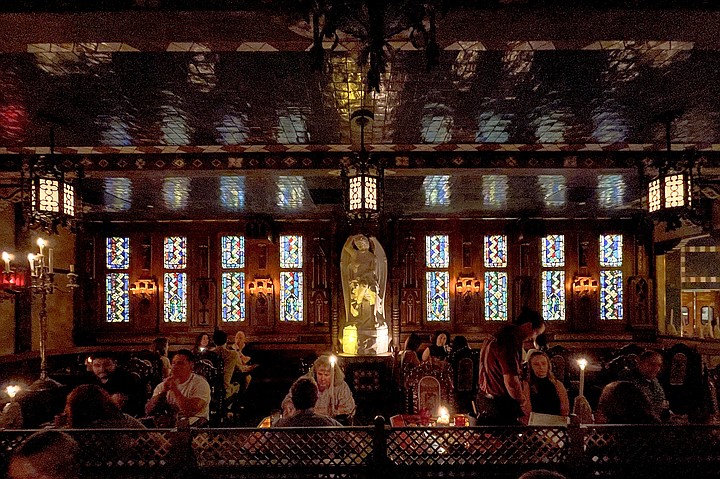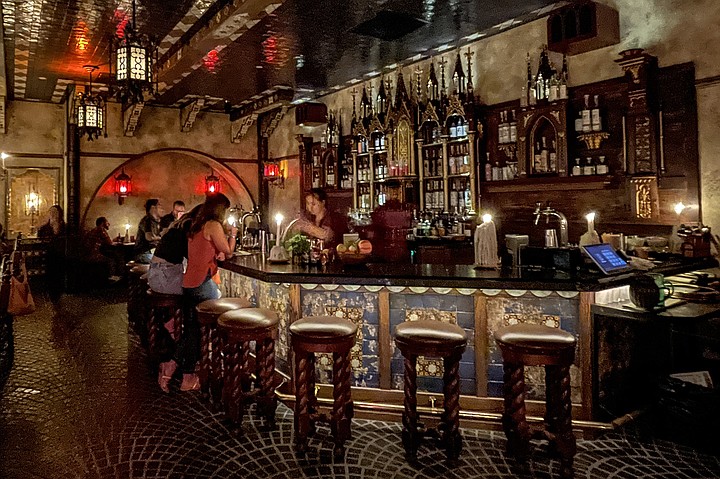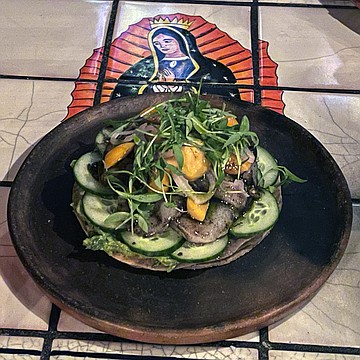Quixote builds a church to Baroque Mexican food
In elaborate remodel of the old Red Fox Room, rich antojitos match the decor
“I’m struggling to remember what it looked like before.”
We’ve come to see what’s been made of the space formerly known as the Red Fox Room. Before it moved into a standalone location across the street, that steakhouse-slash-piano bar held down this northeast corner of the North Park’s Lafayette Hotel for six decades.
Long cherished for its vintage ambience — leather booths, dark wood paneling, and leaded glass — I’d thought of the Red Fox as hard to forget. But so ornate are this new restaurant’s interiors, I can barely recall what my own bedroom looks like, let alone another eatery/drinkery.

It's not just the restaurant. The entire Lafayette has been extensively reimagined with the sort of no-holds-barred maximalism we’ve come to expect from Consortium Holdings. The hospitality group — responsible for such intensively decorated dining spots as Ironside and Morning Glory — got its hands on the Lafayette a couple years back, and promptly got to work with a Brooklyn design studio on a floor-to-ceiling remodel sumptuous enough to make a Gilded Age mansion blush.
My visual cortex has been overstimulated since the moment we set foot in the hotel — its lobby an eccentric mash-up of art deco, rococo, and tiger print. Every color, pattern, and texture has found a place, if not here, then around the hotel bar, down the halls, into the rooms. It’s shiny with polished chrome, wood, and marble; plush with velvet, suede, and tasseled upholstery. There’s a '50s diner, a two-lane bowling alley, and an updated swimming pool that looks like it appeared on an episode of Mad Men.

But most impressive of all may be this refashioned corner restaurant: Quixote. According to the website of said Brooklyn design firm, Post Company, the restaurant and mezcaleria was pieced together from parts of a decommissioned church, salvaged and shipped from somewhere in Mexico. No word on how old a church, exactly, but ancient enough to yield cobblestone floors, elaborate stained-glass windows, ceramic tiles, and “baroque pews.” I can’t recall the last time I dined beneath hand-finished corbels, or ceiling beams likewise painted with the charming decorative patterns of a distant time and place.

Though Quixote clearly namechecks the Man of La Mancha, a region of Spain, its cuisine, like the church, hails from Mexico — most notably Oaxaca. Thanks in large part to its famed seven moles, Oaxacan cuisine may be perceived as occupying the higher end of Mexican dining. So yes, it’s worth pointing out that this may be the priciest Mexican food you’ll encounter in San Diego. After all, prices must reflect the reported $25 million hotel purchase, not to mention the cost of moving a church across international borders.
So, a very short list of sharable entrées (each served with house-made tortillas) starts at $49 — that for a whole roasted fish, such as branzino. A dry-aged ribeye goes for $95. At $63 sits crispy lamb belly, served with chichilo, one of the lesser known of the seven moles, made using charred chili peppers. That would be my choice, were money no object.
Instead, we’ll spend what we have in sampling from the heart of the menu: its small plates. Playing again with the influence of Spain, our server describes them as tapas. But most are what Mexican food aficionados know as antojitos.
The so-called “little cravings” of antojitos bars typically showcase different ways to prepare corn tortillas, and you see that here. There’s the crispy tostada of the scallop and uni aquachile ($18); and the thicker, chewy, sope base of duck carnitas memelita ($15, dressed by a laudable rendition of Oaxaca’s notoriously complex black mole). More exotic is a plaintain and chili tamal, the succulent, steamed masa dressed with yellow mole and topped with mussels escabeche ($16).

The restaurant recommends three order per person to make a complete meal, so even before you consider a $15 mezcal cocktail, the “tapas” can add up. But for a special occasion, I have to concede the experience is worth it, even if you stop yourself at just two plates — and not merely because the masa’s said to be ground from heirloom grains. The mystical, candlelit atmosphere may hinder photography, but Quixote is incredible to behold. It’ll be that much more enjoyable if you get a kick out of seeing highbrow ingredients deliver almost fanciful takes on dishes typically regarded as street food.
Or all-the-way fanciful, as in the case of Quixote’s crab corn doughnut, which turns masa into a savory donut, standing in a puddle of burnt chili emulsion, and topped with a pile of blue crab and caviar ($21). This unexpected dish best embodies the way Quixote’s take on Mexican food matches the baroque spirit of the entire hotel remodel: packed with so many sensory details, you won’t be able to think of anything other than what’s in front of you.